Report on Sustainable Tourism Development: London Olympics Case Study
VerifiedAdded on 2020/10/04
|17
|5814
|58
Report
AI Summary
This report provides a comprehensive analysis of sustainable tourism development, using the London Olympic Games 2012 as a case study. It begins with an introduction to sustainable tourism and its stakeholders, detailing how stakeholders can benefit from tourism planning. The report then explores the advantages and disadvantages of public and private sector tourism partnerships, crucial for successful event execution. Key features of tourism development planning at different levels, including international, national, regional, and sub-regional, are discussed. The significance of interactive planning systems and processes, along with methods for measuring tourist impact (economic and environmental measures), are evaluated. The report defines sustainability in tourism development, identifies hindering factors, and outlines planning stages for sustainability. It addresses conflict resolution, balancing supply and demand, and moral/ethical issues in enclave tourism. Finally, it analyzes current issues in developing and emerging tourist destinations and provides recommendations for future development, concluding with a synthesis of the findings and relevant references.
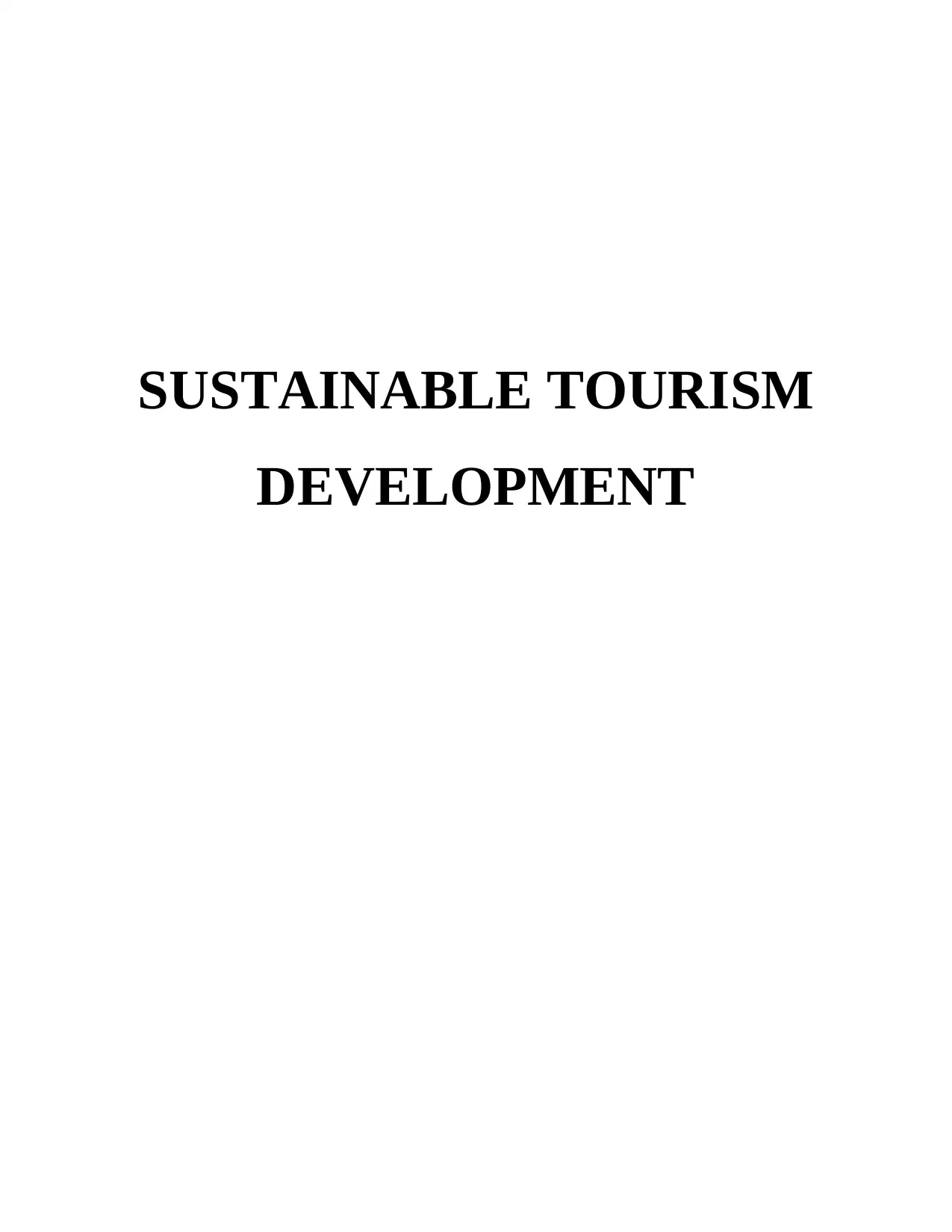
SUSTAINABLE TOURISM
DEVELOPMENT
DEVELOPMENT
Paraphrase This Document
Need a fresh take? Get an instant paraphrase of this document with our AI Paraphraser
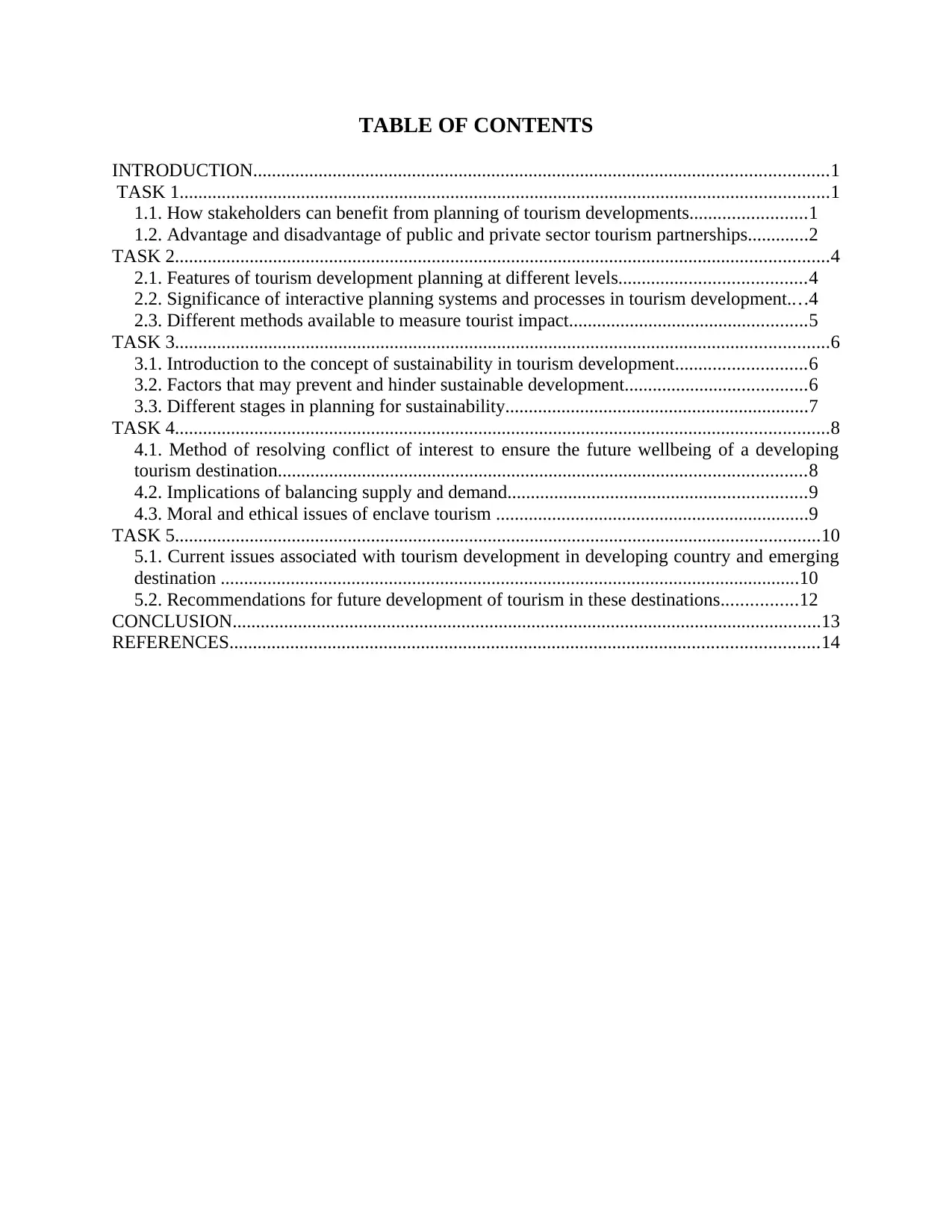
TABLE OF CONTENTS
INTRODUCTION...........................................................................................................................1
TASK 1...........................................................................................................................................1
1.1. How stakeholders can benefit from planning of tourism developments.........................1
1.2. Advantage and disadvantage of public and private sector tourism partnerships.............2
TASK 2............................................................................................................................................4
2.1. Features of tourism development planning at different levels........................................4
2.2. Significance of interactive planning systems and processes in tourism development....4
2.3. Different methods available to measure tourist impact...................................................5
TASK 3............................................................................................................................................6
3.1. Introduction to the concept of sustainability in tourism development............................6
3.2. Factors that may prevent and hinder sustainable development.......................................6
3.3. Different stages in planning for sustainability.................................................................7
TASK 4............................................................................................................................................8
4.1. Method of resolving conflict of interest to ensure the future wellbeing of a developing
tourism destination.................................................................................................................8
4.2. Implications of balancing supply and demand................................................................9
4.3. Moral and ethical issues of enclave tourism ...................................................................9
TASK 5..........................................................................................................................................10
5.1. Current issues associated with tourism development in developing country and emerging
destination ............................................................................................................................10
5.2. Recommendations for future development of tourism in these destinations................12
CONCLUSION..............................................................................................................................13
REFERENCES..............................................................................................................................14
INTRODUCTION...........................................................................................................................1
TASK 1...........................................................................................................................................1
1.1. How stakeholders can benefit from planning of tourism developments.........................1
1.2. Advantage and disadvantage of public and private sector tourism partnerships.............2
TASK 2............................................................................................................................................4
2.1. Features of tourism development planning at different levels........................................4
2.2. Significance of interactive planning systems and processes in tourism development....4
2.3. Different methods available to measure tourist impact...................................................5
TASK 3............................................................................................................................................6
3.1. Introduction to the concept of sustainability in tourism development............................6
3.2. Factors that may prevent and hinder sustainable development.......................................6
3.3. Different stages in planning for sustainability.................................................................7
TASK 4............................................................................................................................................8
4.1. Method of resolving conflict of interest to ensure the future wellbeing of a developing
tourism destination.................................................................................................................8
4.2. Implications of balancing supply and demand................................................................9
4.3. Moral and ethical issues of enclave tourism ...................................................................9
TASK 5..........................................................................................................................................10
5.1. Current issues associated with tourism development in developing country and emerging
destination ............................................................................................................................10
5.2. Recommendations for future development of tourism in these destinations................12
CONCLUSION..............................................................................................................................13
REFERENCES..............................................................................................................................14
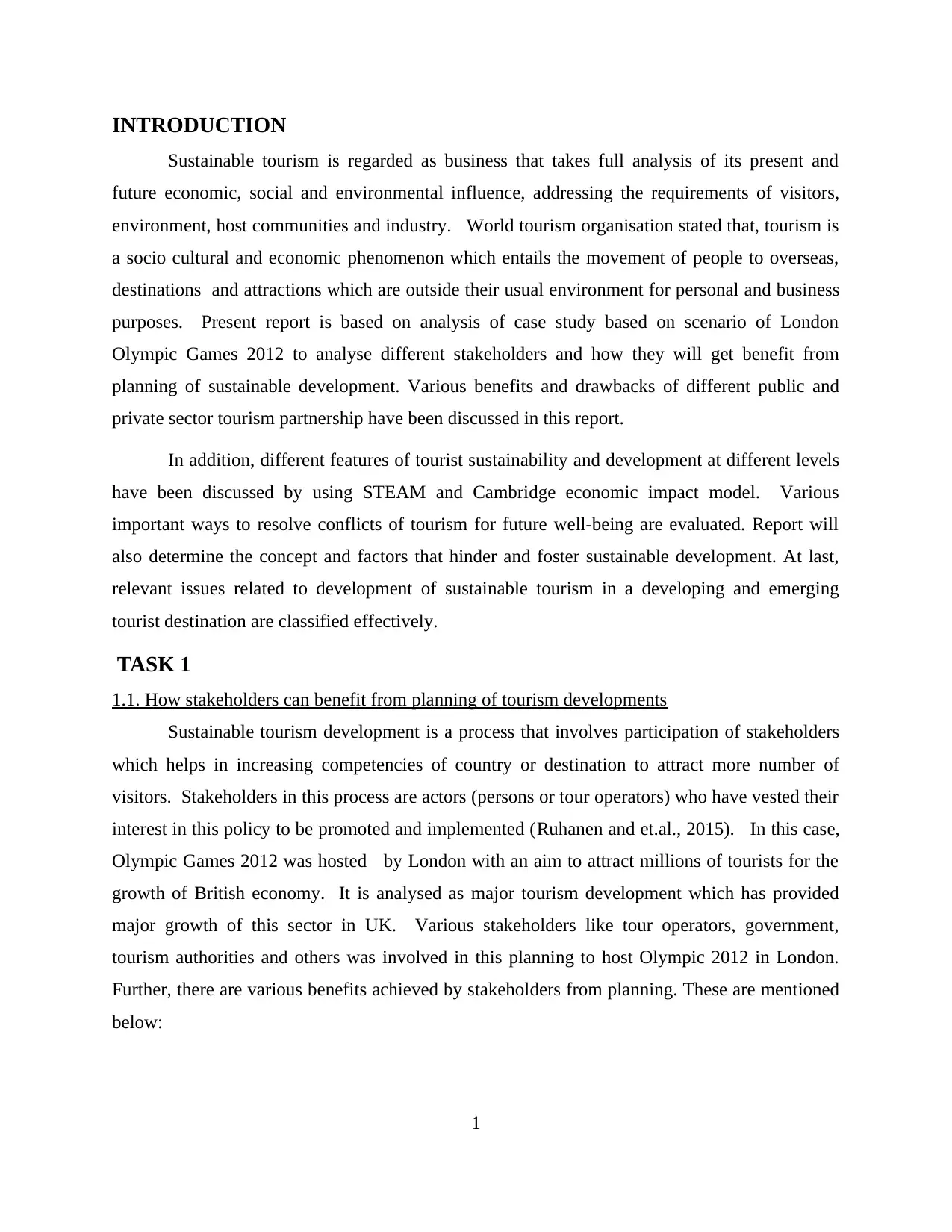
INTRODUCTION
Sustainable tourism is regarded as business that takes full analysis of its present and
future economic, social and environmental influence, addressing the requirements of visitors,
environment, host communities and industry. World tourism organisation stated that, tourism is
a socio cultural and economic phenomenon which entails the movement of people to overseas,
destinations and attractions which are outside their usual environment for personal and business
purposes. Present report is based on analysis of case study based on scenario of London
Olympic Games 2012 to analyse different stakeholders and how they will get benefit from
planning of sustainable development. Various benefits and drawbacks of different public and
private sector tourism partnership have been discussed in this report.
In addition, different features of tourist sustainability and development at different levels
have been discussed by using STEAM and Cambridge economic impact model. Various
important ways to resolve conflicts of tourism for future well-being are evaluated. Report will
also determine the concept and factors that hinder and foster sustainable development. At last,
relevant issues related to development of sustainable tourism in a developing and emerging
tourist destination are classified effectively.
TASK 1
1.1. How stakeholders can benefit from planning of tourism developments
Sustainable tourism development is a process that involves participation of stakeholders
which helps in increasing competencies of country or destination to attract more number of
visitors. Stakeholders in this process are actors (persons or tour operators) who have vested their
interest in this policy to be promoted and implemented (Ruhanen and et.al., 2015). In this case,
Olympic Games 2012 was hosted by London with an aim to attract millions of tourists for the
growth of British economy. It is analysed as major tourism development which has provided
major growth of this sector in UK. Various stakeholders like tour operators, government,
tourism authorities and others was involved in this planning to host Olympic 2012 in London.
Further, there are various benefits achieved by stakeholders from planning. These are mentioned
below:
1
Sustainable tourism is regarded as business that takes full analysis of its present and
future economic, social and environmental influence, addressing the requirements of visitors,
environment, host communities and industry. World tourism organisation stated that, tourism is
a socio cultural and economic phenomenon which entails the movement of people to overseas,
destinations and attractions which are outside their usual environment for personal and business
purposes. Present report is based on analysis of case study based on scenario of London
Olympic Games 2012 to analyse different stakeholders and how they will get benefit from
planning of sustainable development. Various benefits and drawbacks of different public and
private sector tourism partnership have been discussed in this report.
In addition, different features of tourist sustainability and development at different levels
have been discussed by using STEAM and Cambridge economic impact model. Various
important ways to resolve conflicts of tourism for future well-being are evaluated. Report will
also determine the concept and factors that hinder and foster sustainable development. At last,
relevant issues related to development of sustainable tourism in a developing and emerging
tourist destination are classified effectively.
TASK 1
1.1. How stakeholders can benefit from planning of tourism developments
Sustainable tourism development is a process that involves participation of stakeholders
which helps in increasing competencies of country or destination to attract more number of
visitors. Stakeholders in this process are actors (persons or tour operators) who have vested their
interest in this policy to be promoted and implemented (Ruhanen and et.al., 2015). In this case,
Olympic Games 2012 was hosted by London with an aim to attract millions of tourists for the
growth of British economy. It is analysed as major tourism development which has provided
major growth of this sector in UK. Various stakeholders like tour operators, government,
tourism authorities and others was involved in this planning to host Olympic 2012 in London.
Further, there are various benefits achieved by stakeholders from planning. These are mentioned
below:
1
⊘ This is a preview!⊘
Do you want full access?
Subscribe today to unlock all pages.

Trusted by 1+ million students worldwide
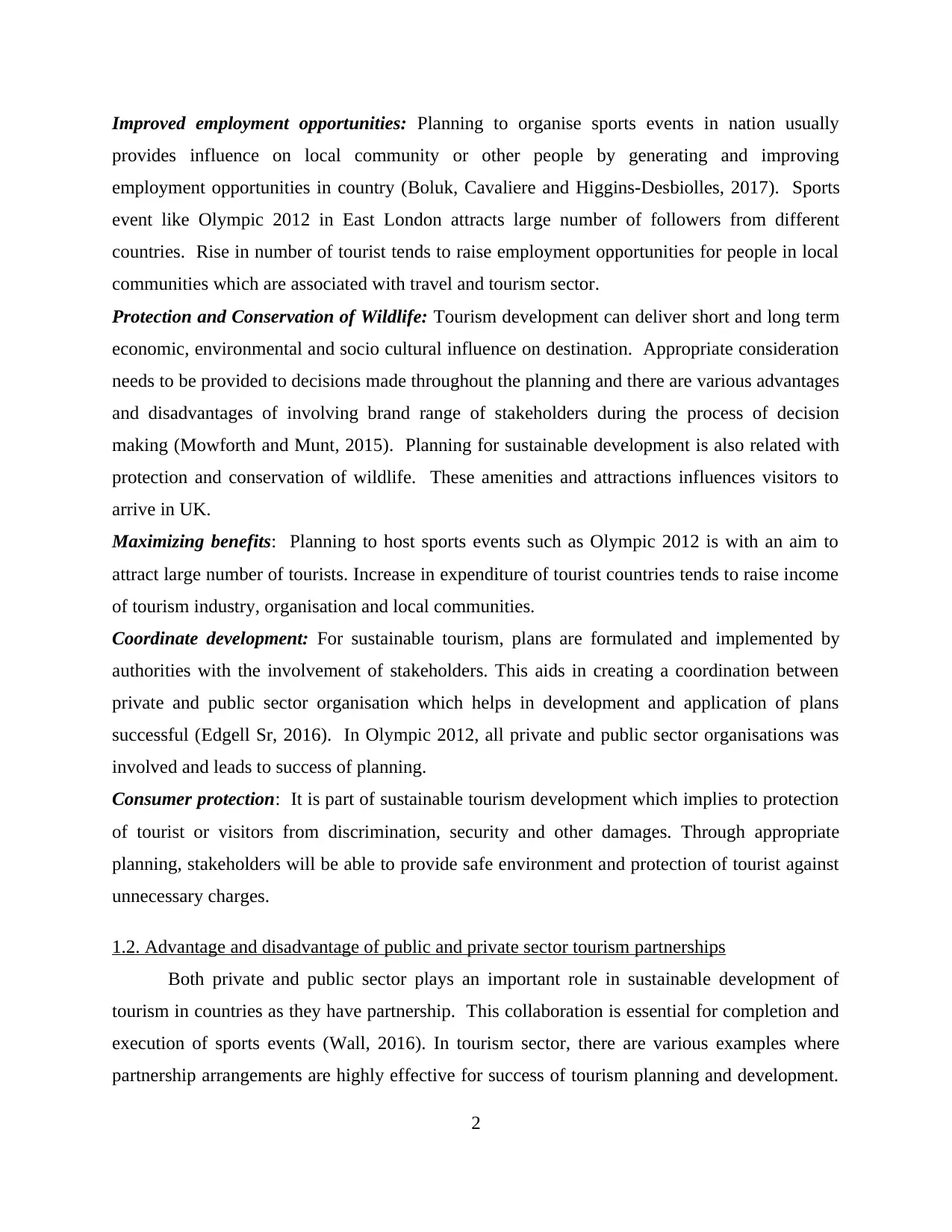
Improved employment opportunities: Planning to organise sports events in nation usually
provides influence on local community or other people by generating and improving
employment opportunities in country (Boluk, Cavaliere and Higgins-Desbiolles, 2017). Sports
event like Olympic 2012 in East London attracts large number of followers from different
countries. Rise in number of tourist tends to raise employment opportunities for people in local
communities which are associated with travel and tourism sector.
Protection and Conservation of Wildlife: Tourism development can deliver short and long term
economic, environmental and socio cultural influence on destination. Appropriate consideration
needs to be provided to decisions made throughout the planning and there are various advantages
and disadvantages of involving brand range of stakeholders during the process of decision
making (Mowforth and Munt, 2015). Planning for sustainable development is also related with
protection and conservation of wildlife. These amenities and attractions influences visitors to
arrive in UK.
Maximizing benefits: Planning to host sports events such as Olympic 2012 is with an aim to
attract large number of tourists. Increase in expenditure of tourist countries tends to raise income
of tourism industry, organisation and local communities.
Coordinate development: For sustainable tourism, plans are formulated and implemented by
authorities with the involvement of stakeholders. This aids in creating a coordination between
private and public sector organisation which helps in development and application of plans
successful (Edgell Sr, 2016). In Olympic 2012, all private and public sector organisations was
involved and leads to success of planning.
Consumer protection: It is part of sustainable tourism development which implies to protection
of tourist or visitors from discrimination, security and other damages. Through appropriate
planning, stakeholders will be able to provide safe environment and protection of tourist against
unnecessary charges.
1.2. Advantage and disadvantage of public and private sector tourism partnerships
Both private and public sector plays an important role in sustainable development of
tourism in countries as they have partnership. This collaboration is essential for completion and
execution of sports events (Wall, 2016). In tourism sector, there are various examples where
partnership arrangements are highly effective for success of tourism planning and development.
2
provides influence on local community or other people by generating and improving
employment opportunities in country (Boluk, Cavaliere and Higgins-Desbiolles, 2017). Sports
event like Olympic 2012 in East London attracts large number of followers from different
countries. Rise in number of tourist tends to raise employment opportunities for people in local
communities which are associated with travel and tourism sector.
Protection and Conservation of Wildlife: Tourism development can deliver short and long term
economic, environmental and socio cultural influence on destination. Appropriate consideration
needs to be provided to decisions made throughout the planning and there are various advantages
and disadvantages of involving brand range of stakeholders during the process of decision
making (Mowforth and Munt, 2015). Planning for sustainable development is also related with
protection and conservation of wildlife. These amenities and attractions influences visitors to
arrive in UK.
Maximizing benefits: Planning to host sports events such as Olympic 2012 is with an aim to
attract large number of tourists. Increase in expenditure of tourist countries tends to raise income
of tourism industry, organisation and local communities.
Coordinate development: For sustainable tourism, plans are formulated and implemented by
authorities with the involvement of stakeholders. This aids in creating a coordination between
private and public sector organisation which helps in development and application of plans
successful (Edgell Sr, 2016). In Olympic 2012, all private and public sector organisations was
involved and leads to success of planning.
Consumer protection: It is part of sustainable tourism development which implies to protection
of tourist or visitors from discrimination, security and other damages. Through appropriate
planning, stakeholders will be able to provide safe environment and protection of tourist against
unnecessary charges.
1.2. Advantage and disadvantage of public and private sector tourism partnerships
Both private and public sector plays an important role in sustainable development of
tourism in countries as they have partnership. This collaboration is essential for completion and
execution of sports events (Wall, 2016). In tourism sector, there are various examples where
partnership arrangements are highly effective for success of tourism planning and development.
2
Paraphrase This Document
Need a fresh take? Get an instant paraphrase of this document with our AI Paraphraser
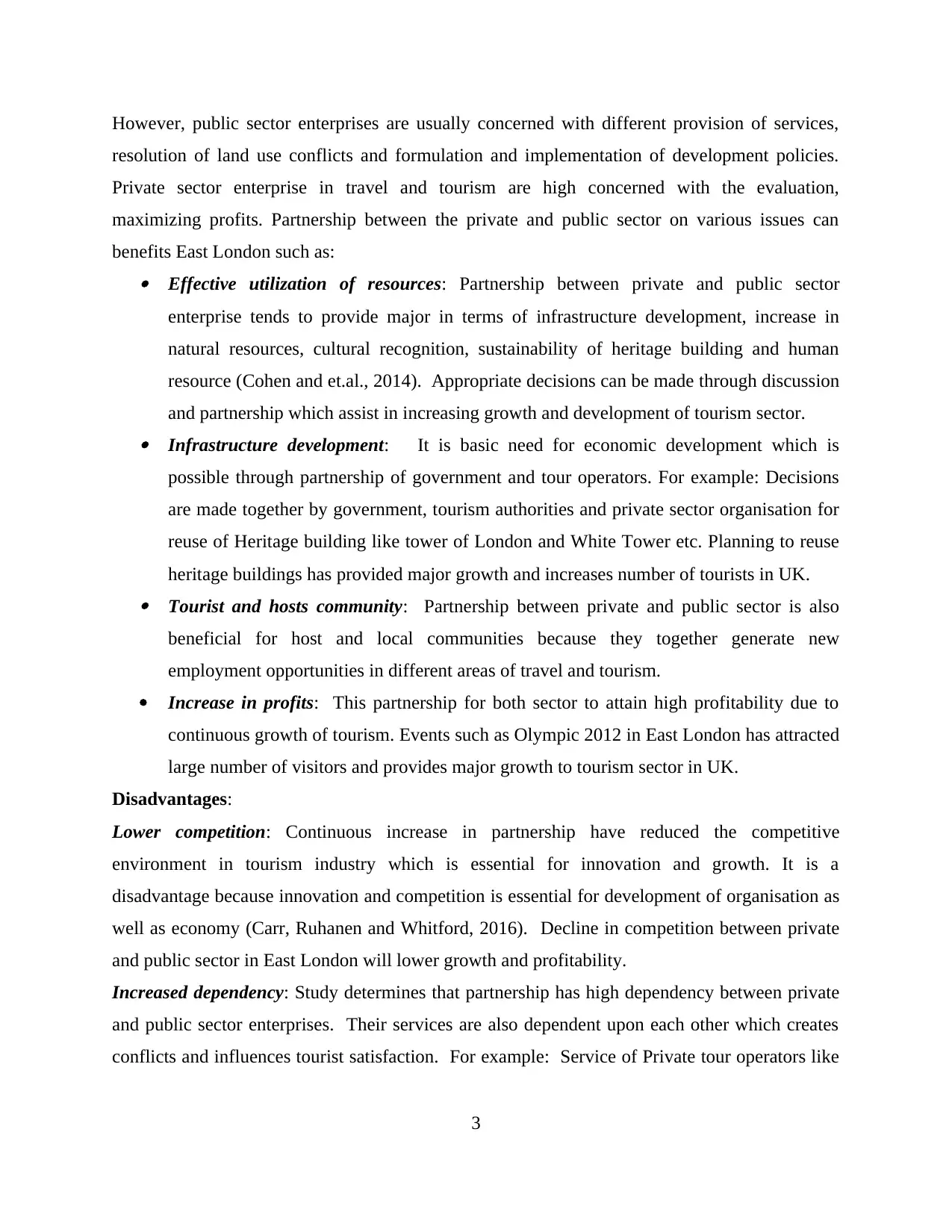
However, public sector enterprises are usually concerned with different provision of services,
resolution of land use conflicts and formulation and implementation of development policies.
Private sector enterprise in travel and tourism are high concerned with the evaluation,
maximizing profits. Partnership between the private and public sector on various issues can
benefits East London such as: Effective utilization of resources: Partnership between private and public sector
enterprise tends to provide major in terms of infrastructure development, increase in
natural resources, cultural recognition, sustainability of heritage building and human
resource (Cohen and et.al., 2014). Appropriate decisions can be made through discussion
and partnership which assist in increasing growth and development of tourism sector. Infrastructure development: It is basic need for economic development which is
possible through partnership of government and tour operators. For example: Decisions
are made together by government, tourism authorities and private sector organisation for
reuse of Heritage building like tower of London and White Tower etc. Planning to reuse
heritage buildings has provided major growth and increases number of tourists in UK. Tourist and hosts community: Partnership between private and public sector is also
beneficial for host and local communities because they together generate new
employment opportunities in different areas of travel and tourism.
Increase in profits: This partnership for both sector to attain high profitability due to
continuous growth of tourism. Events such as Olympic 2012 in East London has attracted
large number of visitors and provides major growth to tourism sector in UK.
Disadvantages:
Lower competition: Continuous increase in partnership have reduced the competitive
environment in tourism industry which is essential for innovation and growth. It is a
disadvantage because innovation and competition is essential for development of organisation as
well as economy (Carr, Ruhanen and Whitford, 2016). Decline in competition between private
and public sector in East London will lower growth and profitability.
Increased dependency: Study determines that partnership has high dependency between private
and public sector enterprises. Their services are also dependent upon each other which creates
conflicts and influences tourist satisfaction. For example: Service of Private tour operators like
3
resolution of land use conflicts and formulation and implementation of development policies.
Private sector enterprise in travel and tourism are high concerned with the evaluation,
maximizing profits. Partnership between the private and public sector on various issues can
benefits East London such as: Effective utilization of resources: Partnership between private and public sector
enterprise tends to provide major in terms of infrastructure development, increase in
natural resources, cultural recognition, sustainability of heritage building and human
resource (Cohen and et.al., 2014). Appropriate decisions can be made through discussion
and partnership which assist in increasing growth and development of tourism sector. Infrastructure development: It is basic need for economic development which is
possible through partnership of government and tour operators. For example: Decisions
are made together by government, tourism authorities and private sector organisation for
reuse of Heritage building like tower of London and White Tower etc. Planning to reuse
heritage buildings has provided major growth and increases number of tourists in UK. Tourist and hosts community: Partnership between private and public sector is also
beneficial for host and local communities because they together generate new
employment opportunities in different areas of travel and tourism.
Increase in profits: This partnership for both sector to attain high profitability due to
continuous growth of tourism. Events such as Olympic 2012 in East London has attracted
large number of visitors and provides major growth to tourism sector in UK.
Disadvantages:
Lower competition: Continuous increase in partnership have reduced the competitive
environment in tourism industry which is essential for innovation and growth. It is a
disadvantage because innovation and competition is essential for development of organisation as
well as economy (Carr, Ruhanen and Whitford, 2016). Decline in competition between private
and public sector in East London will lower growth and profitability.
Increased dependency: Study determines that partnership has high dependency between private
and public sector enterprises. Their services are also dependent upon each other which creates
conflicts and influences tourist satisfaction. For example: Service of Private tour operators like
3
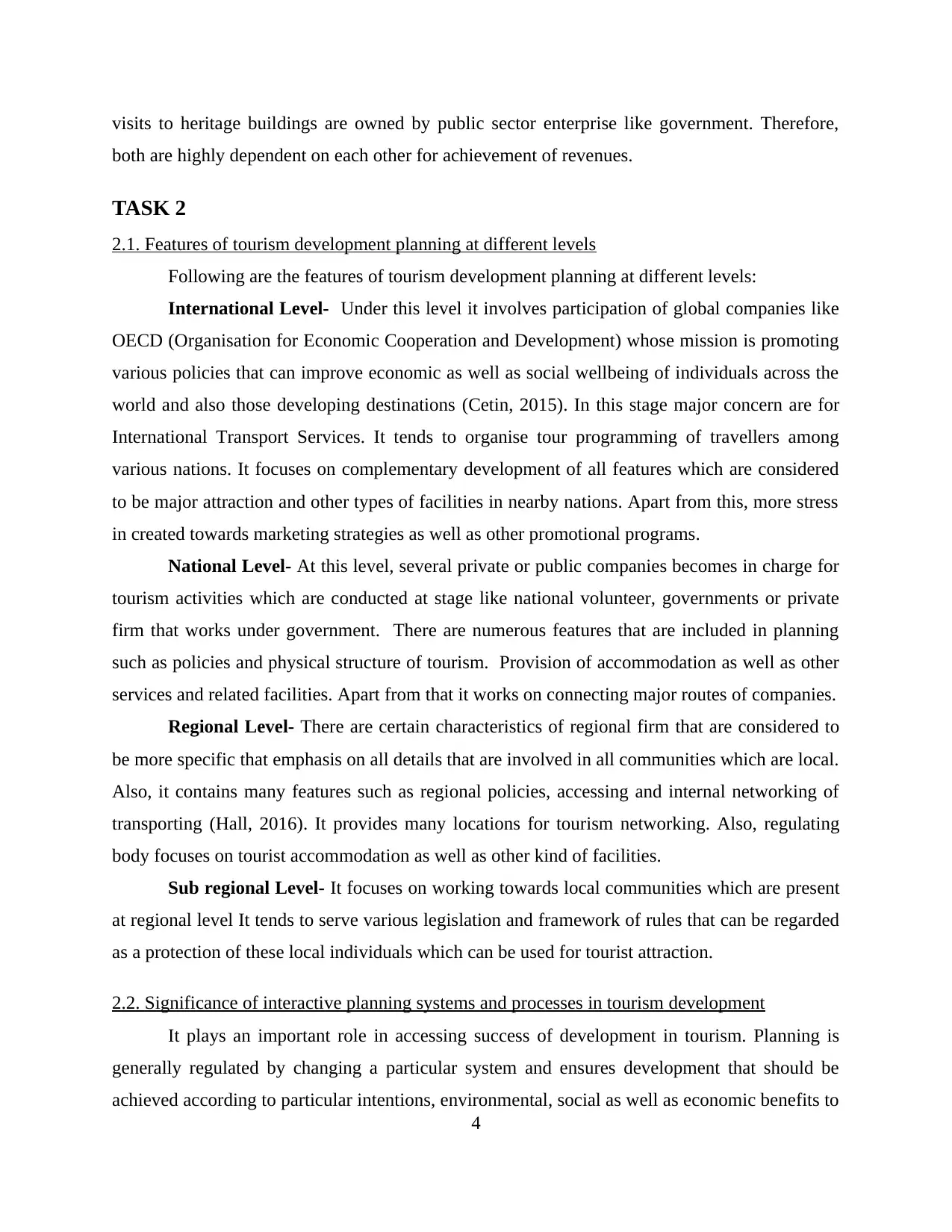
visits to heritage buildings are owned by public sector enterprise like government. Therefore,
both are highly dependent on each other for achievement of revenues.
TASK 2
2.1. Features of tourism development planning at different levels
Following are the features of tourism development planning at different levels:
International Level- Under this level it involves participation of global companies like
OECD (Organisation for Economic Cooperation and Development) whose mission is promoting
various policies that can improve economic as well as social wellbeing of individuals across the
world and also those developing destinations (Cetin, 2015). In this stage major concern are for
International Transport Services. It tends to organise tour programming of travellers among
various nations. It focuses on complementary development of all features which are considered
to be major attraction and other types of facilities in nearby nations. Apart from this, more stress
in created towards marketing strategies as well as other promotional programs.
National Level- At this level, several private or public companies becomes in charge for
tourism activities which are conducted at stage like national volunteer, governments or private
firm that works under government. There are numerous features that are included in planning
such as policies and physical structure of tourism. Provision of accommodation as well as other
services and related facilities. Apart from that it works on connecting major routes of companies.
Regional Level- There are certain characteristics of regional firm that are considered to
be more specific that emphasis on all details that are involved in all communities which are local.
Also, it contains many features such as regional policies, accessing and internal networking of
transporting (Hall, 2016). It provides many locations for tourism networking. Also, regulating
body focuses on tourist accommodation as well as other kind of facilities.
Sub regional Level- It focuses on working towards local communities which are present
at regional level It tends to serve various legislation and framework of rules that can be regarded
as a protection of these local individuals which can be used for tourist attraction.
2.2. Significance of interactive planning systems and processes in tourism development
It plays an important role in accessing success of development in tourism. Planning is
generally regulated by changing a particular system and ensures development that should be
achieved according to particular intentions, environmental, social as well as economic benefits to
4
both are highly dependent on each other for achievement of revenues.
TASK 2
2.1. Features of tourism development planning at different levels
Following are the features of tourism development planning at different levels:
International Level- Under this level it involves participation of global companies like
OECD (Organisation for Economic Cooperation and Development) whose mission is promoting
various policies that can improve economic as well as social wellbeing of individuals across the
world and also those developing destinations (Cetin, 2015). In this stage major concern are for
International Transport Services. It tends to organise tour programming of travellers among
various nations. It focuses on complementary development of all features which are considered
to be major attraction and other types of facilities in nearby nations. Apart from this, more stress
in created towards marketing strategies as well as other promotional programs.
National Level- At this level, several private or public companies becomes in charge for
tourism activities which are conducted at stage like national volunteer, governments or private
firm that works under government. There are numerous features that are included in planning
such as policies and physical structure of tourism. Provision of accommodation as well as other
services and related facilities. Apart from that it works on connecting major routes of companies.
Regional Level- There are certain characteristics of regional firm that are considered to
be more specific that emphasis on all details that are involved in all communities which are local.
Also, it contains many features such as regional policies, accessing and internal networking of
transporting (Hall, 2016). It provides many locations for tourism networking. Also, regulating
body focuses on tourist accommodation as well as other kind of facilities.
Sub regional Level- It focuses on working towards local communities which are present
at regional level It tends to serve various legislation and framework of rules that can be regarded
as a protection of these local individuals which can be used for tourist attraction.
2.2. Significance of interactive planning systems and processes in tourism development
It plays an important role in accessing success of development in tourism. Planning is
generally regulated by changing a particular system and ensures development that should be
achieved according to particular intentions, environmental, social as well as economic benefits to
4
⊘ This is a preview!⊘
Do you want full access?
Subscribe today to unlock all pages.

Trusted by 1+ million students worldwide
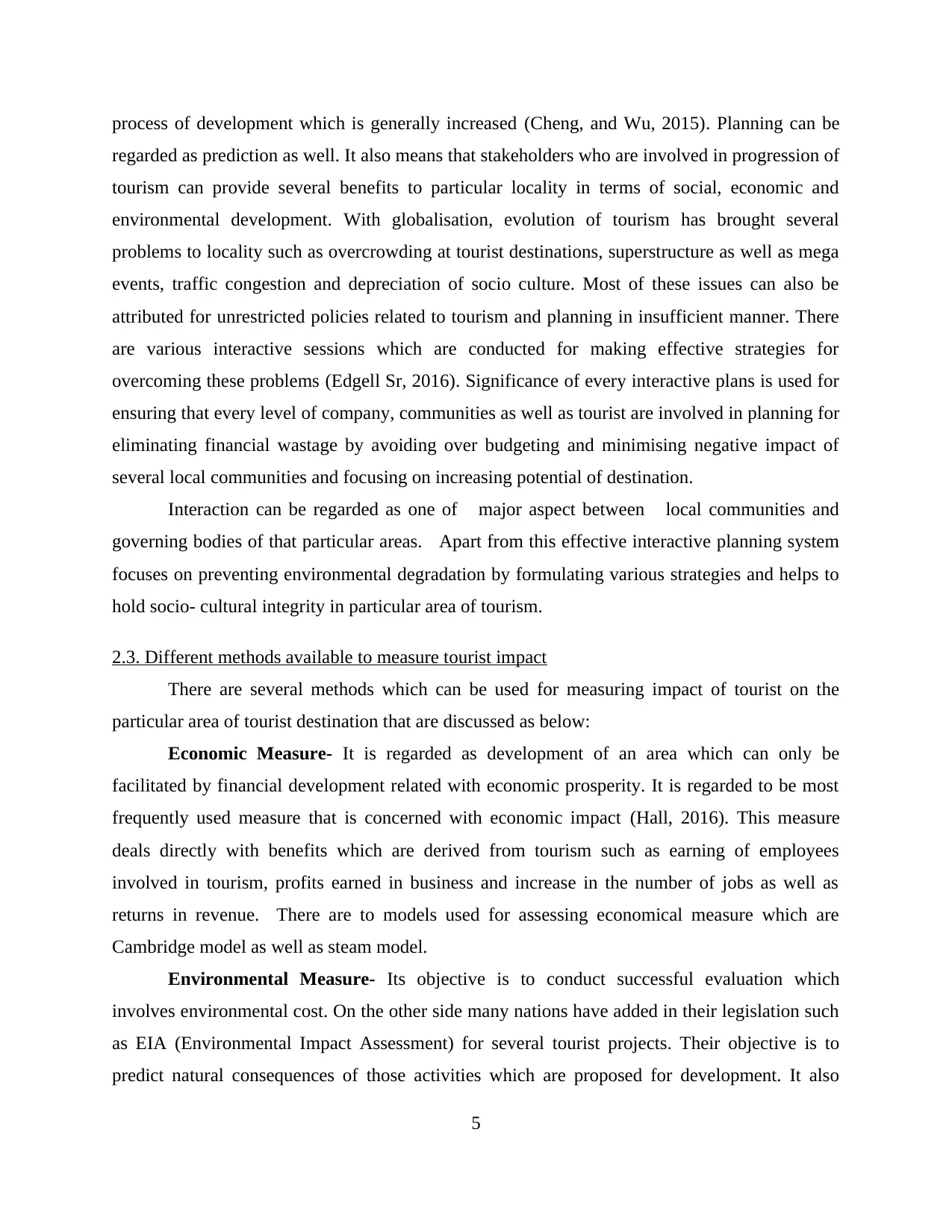
process of development which is generally increased (Cheng, and Wu, 2015). Planning can be
regarded as prediction as well. It also means that stakeholders who are involved in progression of
tourism can provide several benefits to particular locality in terms of social, economic and
environmental development. With globalisation, evolution of tourism has brought several
problems to locality such as overcrowding at tourist destinations, superstructure as well as mega
events, traffic congestion and depreciation of socio culture. Most of these issues can also be
attributed for unrestricted policies related to tourism and planning in insufficient manner. There
are various interactive sessions which are conducted for making effective strategies for
overcoming these problems (Edgell Sr, 2016). Significance of every interactive plans is used for
ensuring that every level of company, communities as well as tourist are involved in planning for
eliminating financial wastage by avoiding over budgeting and minimising negative impact of
several local communities and focusing on increasing potential of destination.
Interaction can be regarded as one of major aspect between local communities and
governing bodies of that particular areas. Apart from this effective interactive planning system
focuses on preventing environmental degradation by formulating various strategies and helps to
hold socio- cultural integrity in particular area of tourism.
2.3. Different methods available to measure tourist impact
There are several methods which can be used for measuring impact of tourist on the
particular area of tourist destination that are discussed as below:
Economic Measure- It is regarded as development of an area which can only be
facilitated by financial development related with economic prosperity. It is regarded to be most
frequently used measure that is concerned with economic impact (Hall, 2016). This measure
deals directly with benefits which are derived from tourism such as earning of employees
involved in tourism, profits earned in business and increase in the number of jobs as well as
returns in revenue. There are to models used for assessing economical measure which are
Cambridge model as well as steam model.
Environmental Measure- Its objective is to conduct successful evaluation which
involves environmental cost. On the other side many nations have added in their legislation such
as EIA (Environmental Impact Assessment) for several tourist projects. Their objective is to
predict natural consequences of those activities which are proposed for development. It also
5
regarded as prediction as well. It also means that stakeholders who are involved in progression of
tourism can provide several benefits to particular locality in terms of social, economic and
environmental development. With globalisation, evolution of tourism has brought several
problems to locality such as overcrowding at tourist destinations, superstructure as well as mega
events, traffic congestion and depreciation of socio culture. Most of these issues can also be
attributed for unrestricted policies related to tourism and planning in insufficient manner. There
are various interactive sessions which are conducted for making effective strategies for
overcoming these problems (Edgell Sr, 2016). Significance of every interactive plans is used for
ensuring that every level of company, communities as well as tourist are involved in planning for
eliminating financial wastage by avoiding over budgeting and minimising negative impact of
several local communities and focusing on increasing potential of destination.
Interaction can be regarded as one of major aspect between local communities and
governing bodies of that particular areas. Apart from this effective interactive planning system
focuses on preventing environmental degradation by formulating various strategies and helps to
hold socio- cultural integrity in particular area of tourism.
2.3. Different methods available to measure tourist impact
There are several methods which can be used for measuring impact of tourist on the
particular area of tourist destination that are discussed as below:
Economic Measure- It is regarded as development of an area which can only be
facilitated by financial development related with economic prosperity. It is regarded to be most
frequently used measure that is concerned with economic impact (Hall, 2016). This measure
deals directly with benefits which are derived from tourism such as earning of employees
involved in tourism, profits earned in business and increase in the number of jobs as well as
returns in revenue. There are to models used for assessing economical measure which are
Cambridge model as well as steam model.
Environmental Measure- Its objective is to conduct successful evaluation which
involves environmental cost. On the other side many nations have added in their legislation such
as EIA (Environmental Impact Assessment) for several tourist projects. Their objective is to
predict natural consequences of those activities which are proposed for development. It also
5
Paraphrase This Document
Need a fresh take? Get an instant paraphrase of this document with our AI Paraphraser
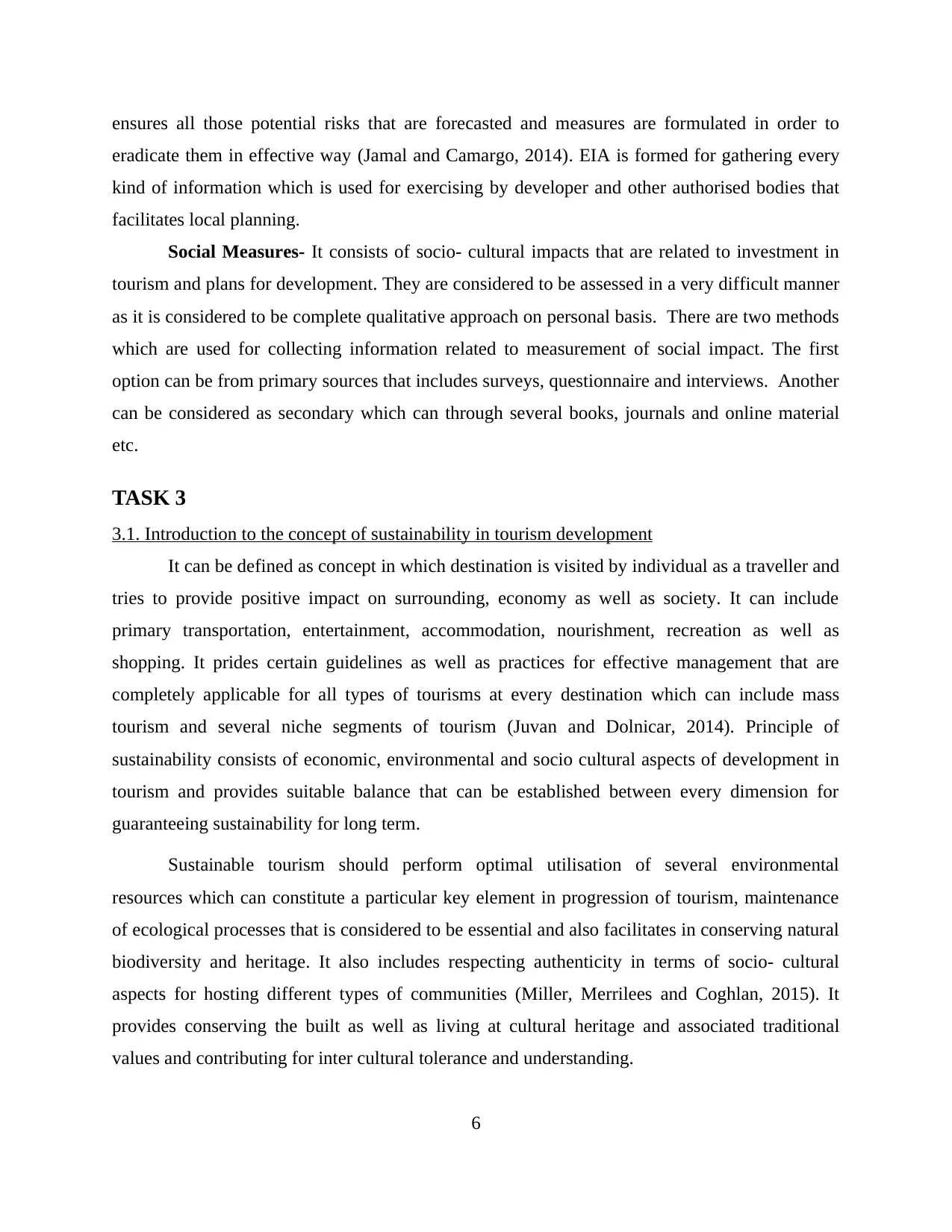
ensures all those potential risks that are forecasted and measures are formulated in order to
eradicate them in effective way (Jamal and Camargo, 2014). EIA is formed for gathering every
kind of information which is used for exercising by developer and other authorised bodies that
facilitates local planning.
Social Measures- It consists of socio- cultural impacts that are related to investment in
tourism and plans for development. They are considered to be assessed in a very difficult manner
as it is considered to be complete qualitative approach on personal basis. There are two methods
which are used for collecting information related to measurement of social impact. The first
option can be from primary sources that includes surveys, questionnaire and interviews. Another
can be considered as secondary which can through several books, journals and online material
etc.
TASK 3
3.1. Introduction to the concept of sustainability in tourism development
It can be defined as concept in which destination is visited by individual as a traveller and
tries to provide positive impact on surrounding, economy as well as society. It can include
primary transportation, entertainment, accommodation, nourishment, recreation as well as
shopping. It prides certain guidelines as well as practices for effective management that are
completely applicable for all types of tourisms at every destination which can include mass
tourism and several niche segments of tourism (Juvan and Dolnicar, 2014). Principle of
sustainability consists of economic, environmental and socio cultural aspects of development in
tourism and provides suitable balance that can be established between every dimension for
guaranteeing sustainability for long term.
Sustainable tourism should perform optimal utilisation of several environmental
resources which can constitute a particular key element in progression of tourism, maintenance
of ecological processes that is considered to be essential and also facilitates in conserving natural
biodiversity and heritage. It also includes respecting authenticity in terms of socio- cultural
aspects for hosting different types of communities (Miller, Merrilees and Coghlan, 2015). It
provides conserving the built as well as living at cultural heritage and associated traditional
values and contributing for inter cultural tolerance and understanding.
6
eradicate them in effective way (Jamal and Camargo, 2014). EIA is formed for gathering every
kind of information which is used for exercising by developer and other authorised bodies that
facilitates local planning.
Social Measures- It consists of socio- cultural impacts that are related to investment in
tourism and plans for development. They are considered to be assessed in a very difficult manner
as it is considered to be complete qualitative approach on personal basis. There are two methods
which are used for collecting information related to measurement of social impact. The first
option can be from primary sources that includes surveys, questionnaire and interviews. Another
can be considered as secondary which can through several books, journals and online material
etc.
TASK 3
3.1. Introduction to the concept of sustainability in tourism development
It can be defined as concept in which destination is visited by individual as a traveller and
tries to provide positive impact on surrounding, economy as well as society. It can include
primary transportation, entertainment, accommodation, nourishment, recreation as well as
shopping. It prides certain guidelines as well as practices for effective management that are
completely applicable for all types of tourisms at every destination which can include mass
tourism and several niche segments of tourism (Juvan and Dolnicar, 2014). Principle of
sustainability consists of economic, environmental and socio cultural aspects of development in
tourism and provides suitable balance that can be established between every dimension for
guaranteeing sustainability for long term.
Sustainable tourism should perform optimal utilisation of several environmental
resources which can constitute a particular key element in progression of tourism, maintenance
of ecological processes that is considered to be essential and also facilitates in conserving natural
biodiversity and heritage. It also includes respecting authenticity in terms of socio- cultural
aspects for hosting different types of communities (Miller, Merrilees and Coghlan, 2015). It
provides conserving the built as well as living at cultural heritage and associated traditional
values and contributing for inter cultural tolerance and understanding.
6
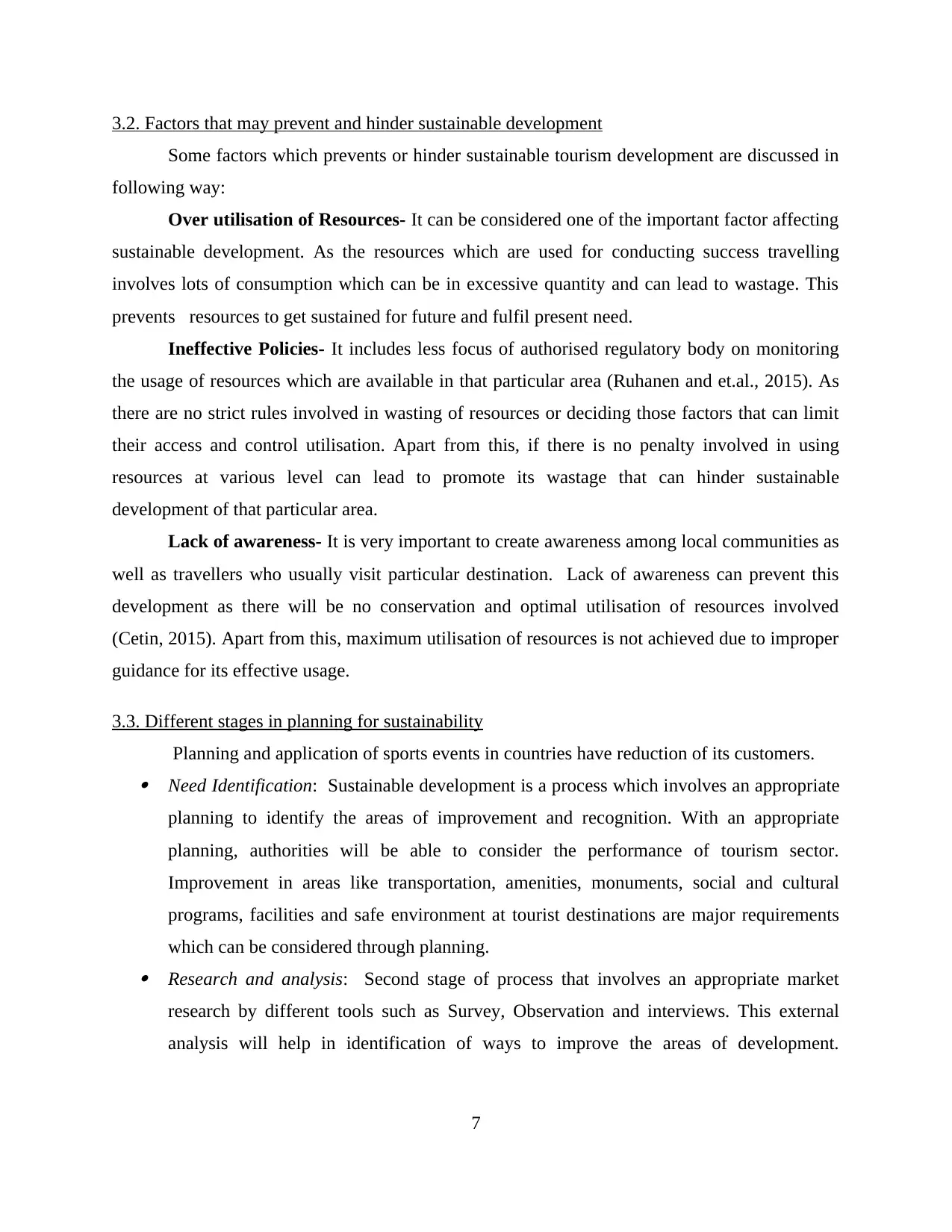
3.2. Factors that may prevent and hinder sustainable development
Some factors which prevents or hinder sustainable tourism development are discussed in
following way:
Over utilisation of Resources- It can be considered one of the important factor affecting
sustainable development. As the resources which are used for conducting success travelling
involves lots of consumption which can be in excessive quantity and can lead to wastage. This
prevents resources to get sustained for future and fulfil present need.
Ineffective Policies- It includes less focus of authorised regulatory body on monitoring
the usage of resources which are available in that particular area (Ruhanen and et.al., 2015). As
there are no strict rules involved in wasting of resources or deciding those factors that can limit
their access and control utilisation. Apart from this, if there is no penalty involved in using
resources at various level can lead to promote its wastage that can hinder sustainable
development of that particular area.
Lack of awareness- It is very important to create awareness among local communities as
well as travellers who usually visit particular destination. Lack of awareness can prevent this
development as there will be no conservation and optimal utilisation of resources involved
(Cetin, 2015). Apart from this, maximum utilisation of resources is not achieved due to improper
guidance for its effective usage.
3.3. Different stages in planning for sustainability
Planning and application of sports events in countries have reduction of its customers. Need Identification: Sustainable development is a process which involves an appropriate
planning to identify the areas of improvement and recognition. With an appropriate
planning, authorities will be able to consider the performance of tourism sector.
Improvement in areas like transportation, amenities, monuments, social and cultural
programs, facilities and safe environment at tourist destinations are major requirements
which can be considered through planning. Research and analysis: Second stage of process that involves an appropriate market
research by different tools such as Survey, Observation and interviews. This external
analysis will help in identification of ways to improve the areas of development.
7
Some factors which prevents or hinder sustainable tourism development are discussed in
following way:
Over utilisation of Resources- It can be considered one of the important factor affecting
sustainable development. As the resources which are used for conducting success travelling
involves lots of consumption which can be in excessive quantity and can lead to wastage. This
prevents resources to get sustained for future and fulfil present need.
Ineffective Policies- It includes less focus of authorised regulatory body on monitoring
the usage of resources which are available in that particular area (Ruhanen and et.al., 2015). As
there are no strict rules involved in wasting of resources or deciding those factors that can limit
their access and control utilisation. Apart from this, if there is no penalty involved in using
resources at various level can lead to promote its wastage that can hinder sustainable
development of that particular area.
Lack of awareness- It is very important to create awareness among local communities as
well as travellers who usually visit particular destination. Lack of awareness can prevent this
development as there will be no conservation and optimal utilisation of resources involved
(Cetin, 2015). Apart from this, maximum utilisation of resources is not achieved due to improper
guidance for its effective usage.
3.3. Different stages in planning for sustainability
Planning and application of sports events in countries have reduction of its customers. Need Identification: Sustainable development is a process which involves an appropriate
planning to identify the areas of improvement and recognition. With an appropriate
planning, authorities will be able to consider the performance of tourism sector.
Improvement in areas like transportation, amenities, monuments, social and cultural
programs, facilities and safe environment at tourist destinations are major requirements
which can be considered through planning. Research and analysis: Second stage of process that involves an appropriate market
research by different tools such as Survey, Observation and interviews. This external
analysis will help in identification of ways to improve the areas of development.
7
⊘ This is a preview!⊘
Do you want full access?
Subscribe today to unlock all pages.

Trusted by 1+ million students worldwide
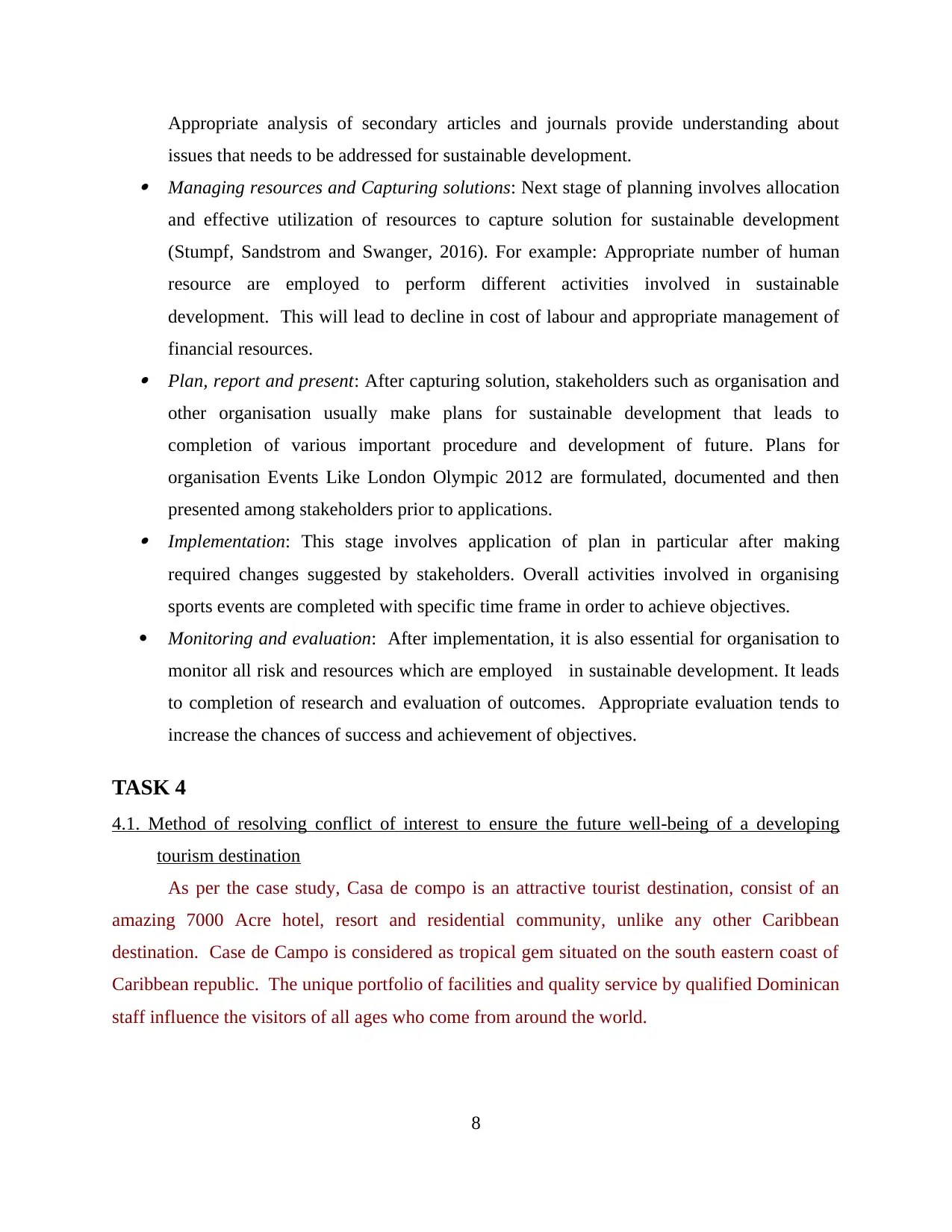
Appropriate analysis of secondary articles and journals provide understanding about
issues that needs to be addressed for sustainable development. Managing resources and Capturing solutions: Next stage of planning involves allocation
and effective utilization of resources to capture solution for sustainable development
(Stumpf, Sandstrom and Swanger, 2016). For example: Appropriate number of human
resource are employed to perform different activities involved in sustainable
development. This will lead to decline in cost of labour and appropriate management of
financial resources. Plan, report and present: After capturing solution, stakeholders such as organisation and
other organisation usually make plans for sustainable development that leads to
completion of various important procedure and development of future. Plans for
organisation Events Like London Olympic 2012 are formulated, documented and then
presented among stakeholders prior to applications. Implementation: This stage involves application of plan in particular after making
required changes suggested by stakeholders. Overall activities involved in organising
sports events are completed with specific time frame in order to achieve objectives.
Monitoring and evaluation: After implementation, it is also essential for organisation to
monitor all risk and resources which are employed in sustainable development. It leads
to completion of research and evaluation of outcomes. Appropriate evaluation tends to
increase the chances of success and achievement of objectives.
TASK 4
4.1. Method of resolving conflict of interest to ensure the future well-being of a developing
tourism destination
As per the case study, Casa de compo is an attractive tourist destination, consist of an
amazing 7000 Acre hotel, resort and residential community, unlike any other Caribbean
destination. Case de Campo is considered as tropical gem situated on the south eastern coast of
Caribbean republic. The unique portfolio of facilities and quality service by qualified Dominican
staff influence the visitors of all ages who come from around the world.
8
issues that needs to be addressed for sustainable development. Managing resources and Capturing solutions: Next stage of planning involves allocation
and effective utilization of resources to capture solution for sustainable development
(Stumpf, Sandstrom and Swanger, 2016). For example: Appropriate number of human
resource are employed to perform different activities involved in sustainable
development. This will lead to decline in cost of labour and appropriate management of
financial resources. Plan, report and present: After capturing solution, stakeholders such as organisation and
other organisation usually make plans for sustainable development that leads to
completion of various important procedure and development of future. Plans for
organisation Events Like London Olympic 2012 are formulated, documented and then
presented among stakeholders prior to applications. Implementation: This stage involves application of plan in particular after making
required changes suggested by stakeholders. Overall activities involved in organising
sports events are completed with specific time frame in order to achieve objectives.
Monitoring and evaluation: After implementation, it is also essential for organisation to
monitor all risk and resources which are employed in sustainable development. It leads
to completion of research and evaluation of outcomes. Appropriate evaluation tends to
increase the chances of success and achievement of objectives.
TASK 4
4.1. Method of resolving conflict of interest to ensure the future well-being of a developing
tourism destination
As per the case study, Casa de compo is an attractive tourist destination, consist of an
amazing 7000 Acre hotel, resort and residential community, unlike any other Caribbean
destination. Case de Campo is considered as tropical gem situated on the south eastern coast of
Caribbean republic. The unique portfolio of facilities and quality service by qualified Dominican
staff influence the visitors of all ages who come from around the world.
8
Paraphrase This Document
Need a fresh take? Get an instant paraphrase of this document with our AI Paraphraser
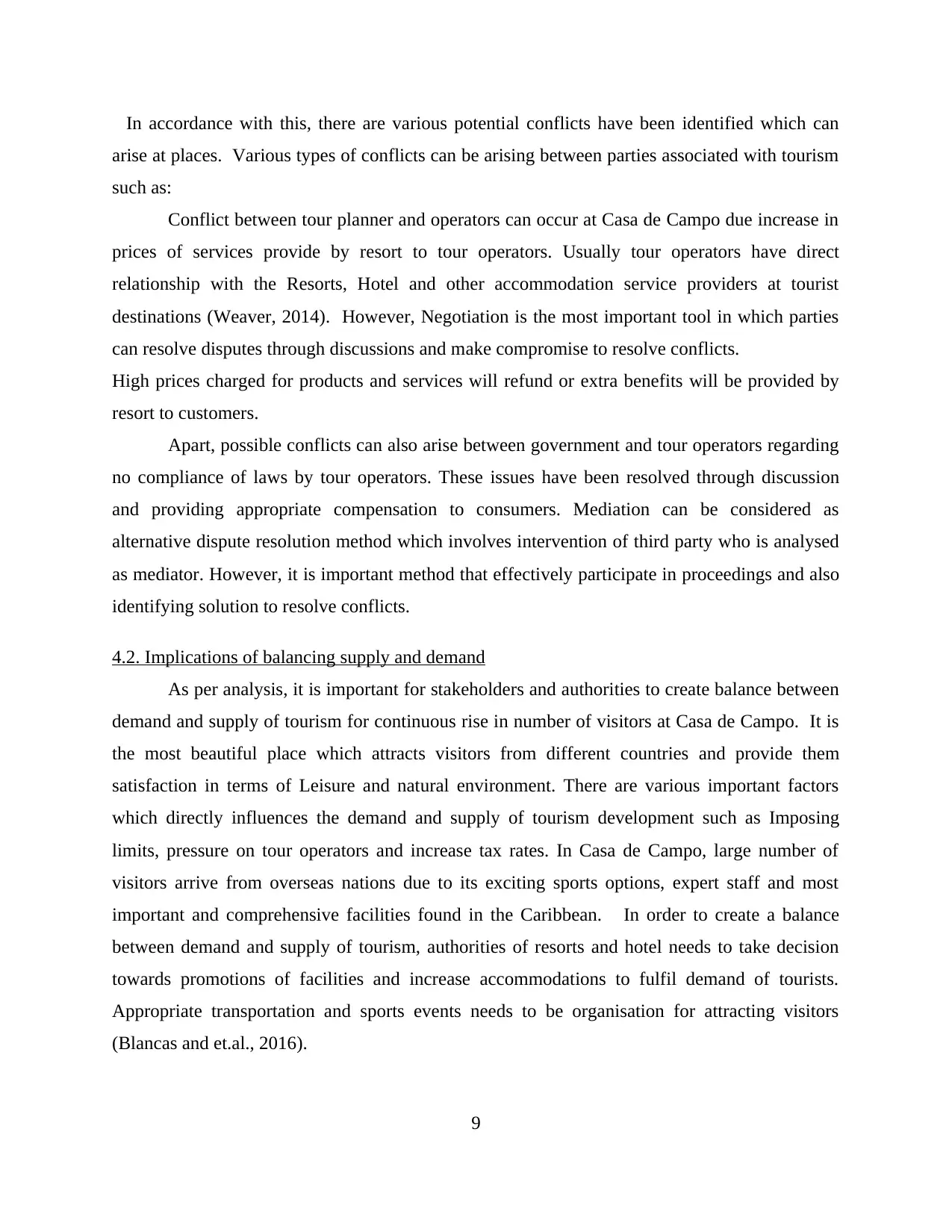
In accordance with this, there are various potential conflicts have been identified which can
arise at places. Various types of conflicts can be arising between parties associated with tourism
such as:
Conflict between tour planner and operators can occur at Casa de Campo due increase in
prices of services provide by resort to tour operators. Usually tour operators have direct
relationship with the Resorts, Hotel and other accommodation service providers at tourist
destinations (Weaver, 2014). However, Negotiation is the most important tool in which parties
can resolve disputes through discussions and make compromise to resolve conflicts.
High prices charged for products and services will refund or extra benefits will be provided by
resort to customers.
Apart, possible conflicts can also arise between government and tour operators regarding
no compliance of laws by tour operators. These issues have been resolved through discussion
and providing appropriate compensation to consumers. Mediation can be considered as
alternative dispute resolution method which involves intervention of third party who is analysed
as mediator. However, it is important method that effectively participate in proceedings and also
identifying solution to resolve conflicts.
4.2. Implications of balancing supply and demand
As per analysis, it is important for stakeholders and authorities to create balance between
demand and supply of tourism for continuous rise in number of visitors at Casa de Campo. It is
the most beautiful place which attracts visitors from different countries and provide them
satisfaction in terms of Leisure and natural environment. There are various important factors
which directly influences the demand and supply of tourism development such as Imposing
limits, pressure on tour operators and increase tax rates. In Casa de Campo, large number of
visitors arrive from overseas nations due to its exciting sports options, expert staff and most
important and comprehensive facilities found in the Caribbean. In order to create a balance
between demand and supply of tourism, authorities of resorts and hotel needs to take decision
towards promotions of facilities and increase accommodations to fulfil demand of tourists.
Appropriate transportation and sports events needs to be organisation for attracting visitors
(Blancas and et.al., 2016).
9
arise at places. Various types of conflicts can be arising between parties associated with tourism
such as:
Conflict between tour planner and operators can occur at Casa de Campo due increase in
prices of services provide by resort to tour operators. Usually tour operators have direct
relationship with the Resorts, Hotel and other accommodation service providers at tourist
destinations (Weaver, 2014). However, Negotiation is the most important tool in which parties
can resolve disputes through discussions and make compromise to resolve conflicts.
High prices charged for products and services will refund or extra benefits will be provided by
resort to customers.
Apart, possible conflicts can also arise between government and tour operators regarding
no compliance of laws by tour operators. These issues have been resolved through discussion
and providing appropriate compensation to consumers. Mediation can be considered as
alternative dispute resolution method which involves intervention of third party who is analysed
as mediator. However, it is important method that effectively participate in proceedings and also
identifying solution to resolve conflicts.
4.2. Implications of balancing supply and demand
As per analysis, it is important for stakeholders and authorities to create balance between
demand and supply of tourism for continuous rise in number of visitors at Casa de Campo. It is
the most beautiful place which attracts visitors from different countries and provide them
satisfaction in terms of Leisure and natural environment. There are various important factors
which directly influences the demand and supply of tourism development such as Imposing
limits, pressure on tour operators and increase tax rates. In Casa de Campo, large number of
visitors arrive from overseas nations due to its exciting sports options, expert staff and most
important and comprehensive facilities found in the Caribbean. In order to create a balance
between demand and supply of tourism, authorities of resorts and hotel needs to take decision
towards promotions of facilities and increase accommodations to fulfil demand of tourists.
Appropriate transportation and sports events needs to be organisation for attracting visitors
(Blancas and et.al., 2016).
9
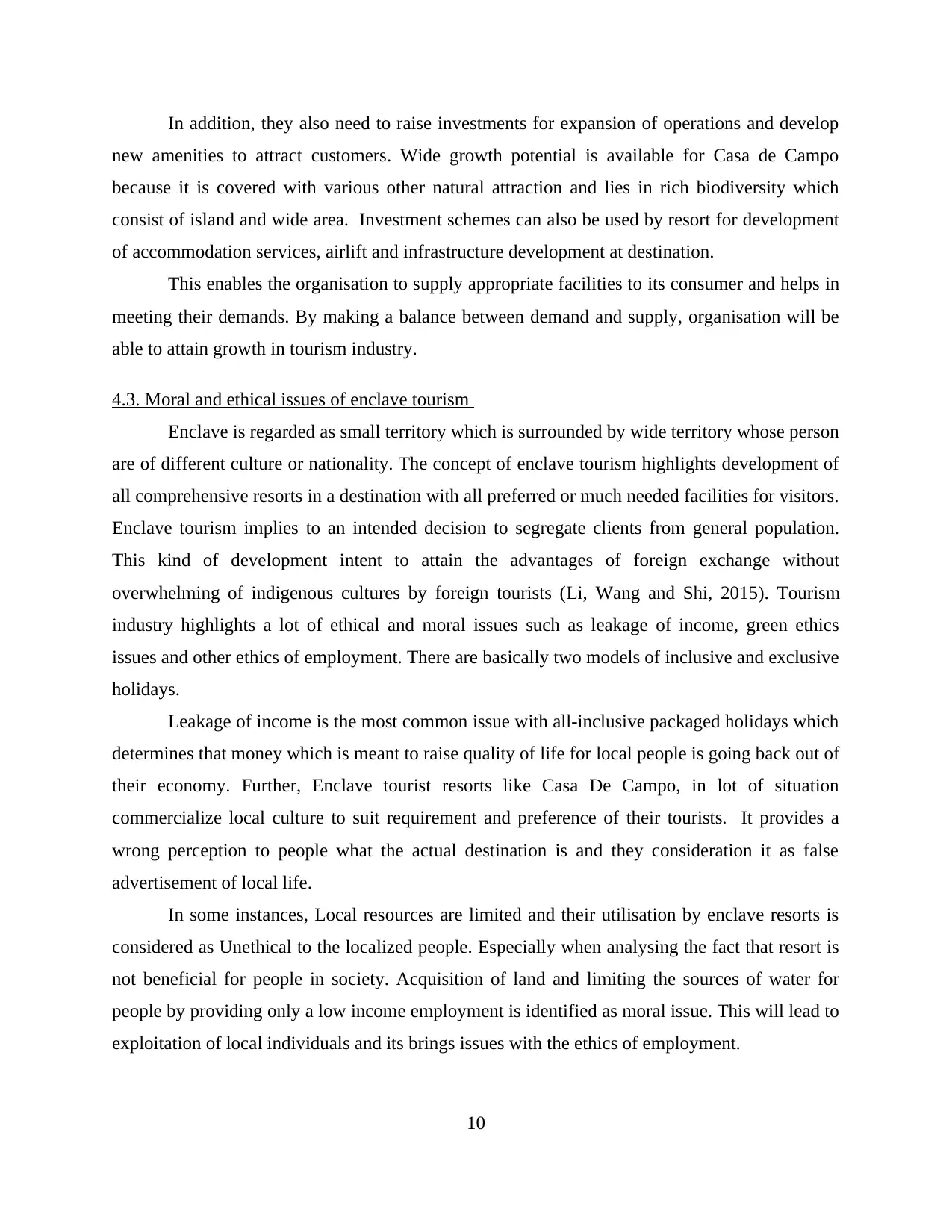
In addition, they also need to raise investments for expansion of operations and develop
new amenities to attract customers. Wide growth potential is available for Casa de Campo
because it is covered with various other natural attraction and lies in rich biodiversity which
consist of island and wide area. Investment schemes can also be used by resort for development
of accommodation services, airlift and infrastructure development at destination.
This enables the organisation to supply appropriate facilities to its consumer and helps in
meeting their demands. By making a balance between demand and supply, organisation will be
able to attain growth in tourism industry.
4.3. Moral and ethical issues of enclave tourism
Enclave is regarded as small territory which is surrounded by wide territory whose person
are of different culture or nationality. The concept of enclave tourism highlights development of
all comprehensive resorts in a destination with all preferred or much needed facilities for visitors.
Enclave tourism implies to an intended decision to segregate clients from general population.
This kind of development intent to attain the advantages of foreign exchange without
overwhelming of indigenous cultures by foreign tourists (Li, Wang and Shi, 2015). Tourism
industry highlights a lot of ethical and moral issues such as leakage of income, green ethics
issues and other ethics of employment. There are basically two models of inclusive and exclusive
holidays.
Leakage of income is the most common issue with all-inclusive packaged holidays which
determines that money which is meant to raise quality of life for local people is going back out of
their economy. Further, Enclave tourist resorts like Casa De Campo, in lot of situation
commercialize local culture to suit requirement and preference of their tourists. It provides a
wrong perception to people what the actual destination is and they consideration it as false
advertisement of local life.
In some instances, Local resources are limited and their utilisation by enclave resorts is
considered as Unethical to the localized people. Especially when analysing the fact that resort is
not beneficial for people in society. Acquisition of land and limiting the sources of water for
people by providing only a low income employment is identified as moral issue. This will lead to
exploitation of local individuals and its brings issues with the ethics of employment.
10
new amenities to attract customers. Wide growth potential is available for Casa de Campo
because it is covered with various other natural attraction and lies in rich biodiversity which
consist of island and wide area. Investment schemes can also be used by resort for development
of accommodation services, airlift and infrastructure development at destination.
This enables the organisation to supply appropriate facilities to its consumer and helps in
meeting their demands. By making a balance between demand and supply, organisation will be
able to attain growth in tourism industry.
4.3. Moral and ethical issues of enclave tourism
Enclave is regarded as small territory which is surrounded by wide territory whose person
are of different culture or nationality. The concept of enclave tourism highlights development of
all comprehensive resorts in a destination with all preferred or much needed facilities for visitors.
Enclave tourism implies to an intended decision to segregate clients from general population.
This kind of development intent to attain the advantages of foreign exchange without
overwhelming of indigenous cultures by foreign tourists (Li, Wang and Shi, 2015). Tourism
industry highlights a lot of ethical and moral issues such as leakage of income, green ethics
issues and other ethics of employment. There are basically two models of inclusive and exclusive
holidays.
Leakage of income is the most common issue with all-inclusive packaged holidays which
determines that money which is meant to raise quality of life for local people is going back out of
their economy. Further, Enclave tourist resorts like Casa De Campo, in lot of situation
commercialize local culture to suit requirement and preference of their tourists. It provides a
wrong perception to people what the actual destination is and they consideration it as false
advertisement of local life.
In some instances, Local resources are limited and their utilisation by enclave resorts is
considered as Unethical to the localized people. Especially when analysing the fact that resort is
not beneficial for people in society. Acquisition of land and limiting the sources of water for
people by providing only a low income employment is identified as moral issue. This will lead to
exploitation of local individuals and its brings issues with the ethics of employment.
10
⊘ This is a preview!⊘
Do you want full access?
Subscribe today to unlock all pages.

Trusted by 1+ million students worldwide
1 out of 17
Related Documents
Your All-in-One AI-Powered Toolkit for Academic Success.
+13062052269
info@desklib.com
Available 24*7 on WhatsApp / Email
![[object Object]](/_next/static/media/star-bottom.7253800d.svg)
Unlock your academic potential
Copyright © 2020–2025 A2Z Services. All Rights Reserved. Developed and managed by ZUCOL.




